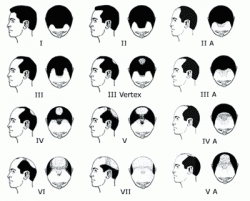This web page was produced as an assignment for Gen677 at UW-Madison Spring 2009.
Male Pattern Baldness (androgenic alopecia)

"Yep. Classic Horseshoe Pattern. I've see a lot of this...You've still got pretty good coverage. Once the enemy advances beyond this perimeter, then you won't be Kurt anymore."-George Costanza
Quote from SeinfeldScripts and image from BaldRus.
Introduction
Androgenic alopecia (AGA), also referred to as male pattern baldness, is a common dermatolgic condition afflicting nearly 50% percent of Caucasian males over the age of 50. AGA is less frequent in males of Asian, American-Indian, or African decent, yet manifests itself in a characteristic and predictable way in all cases. The recognizable pattern is really 1 of 7 variants on the Hamilton-Norwood scale(see figure), which was developed in 1975 (1). The pattern has since become classified as a combination of both a receding frontal hairline and partial or complete hair loss in the vertex region of the scalp(2). In most cases some hair remains to form a ring around the temporal, parietal, and occipital regions.....the classic horseshoe pattern.
Hamilton-Norwood Scale

Standards for classification of most common types of male pattern baldness. Fig. 1, Norwood, 1975
Genetic basis of male pattern baldness
There are two isoenzymes of 5-alpha reductase found in the human genome, type 1 and type 2. The main action of both isoenzymes is the conversion of testosterone into the more potent androgen dihydrotestosterone (DHT). SRD5A2 is the gene that codes for the protein product that is responsible for the pathogenesis of male pattern baldness. Studies using monoclonal antibodies have found type 2 5AR localized in the vertex and frontal scalp, but not the occipital regions. Furthermore, these same regions have been shown to be androgen sensitive, meaning the hair grows constitutively in the absence of the hormone. In the presence of abundant DHT, the hair follicles become miniaturized; resulting in fine, short hair that is prone to fall out(5).
The inheritance of male pattern baldness may involve more genes and becomes more complex as more discoveries are made (see gene info page). There is however much classical evidence that pinpoints the direct involvement of DHT in male pattern baldness. Studies of pseudohermaphrodites (lacking 5AR) showed protection from male pattern baldness throughout life. It has also been shown that the introduction of exogenous testosterone into castrated males can induce typical patterns of hair loss. Finally, inhibitors of the enzyme have slowed the rate of hair loss, indicating a direct involvement(4).
A notable condition
Q: Why do bald-headed men never use keys?
A: Because they've lost their locks.
From Best Funny Jokes.
Whether male pattern baldness is the punchline of a joke or simply a memorable characteristic of your favorite TV sitcom star, it is a serious condition that can have profound affects. Multiple studies have been conducted that relate male pattern baldness with conditions such as coronary heart disease, hyperinsulinemia, and even obesity. With nearly half of the adult population afflicted, these associations present higher cause for concern than just ones receding hairline. On top of the physical implications, there are many emotional problems linked to being bald. In US culture, hair is often a sign of physical attractiveness or can be used as a form of self-expression, so naturally going bald may have negative effects on self-image. Throughout history a vibrant head of hair has also been seen as a sign of virility and health, while balding conjures such negative connotations as impotency and decrepitude(3). So one must think twice when making a bald joke, because if statistics are any clear indication there is a good chance that they will lose some or all of their hair.
The purpose of my semester long project will be to characterize male pattern baldness along with the genes responsible for it. In doing so I hope to expose any myths about the condition, as well as present some cutting edge research on its genetic basis.
References
1. Norwood, O'tar T. (1975) Male Pattern Baldness: classification and Incidence. Southern medical journal, 68(11):1359-1365
2. Hoffman, R. (2002). Male Androgenetic Alopecia. Clinical and Experimental dermatology, 27(5): 373-382. doi:10.1046/j.1365-2230.2002.01086.x
3. Stough, D., Stenn, K., Haber, R., Parsley, W.M., Vogel, J.E., Whiting, D.A., & Washenik, K. (2005). Psychological Effect, Pathophysiology, and Management of Androgenetic Alopecia in Men. Mayo Clin Proc., 80(10):1316-1322. doi:10.4065/80.10.1316
4. Nyholt, R.D., Gillespie, N.A., Heath, A.C., and Martin, N.G. (2003) Genetic Basis of Male Pattern Baldness. Journal of Investigative Dermatology, 121:1561-1564. doi:doi:10.1111/j.1523-1747.2003.12615.x
5. Kaufman, K.D. (2002) Androgens and Alopecia. Molecular and Clinical Endocrinology, 198(10):89-95. doi:10.1016/S0303-7207(02)00372-6
Website construction:
Christopher Nicholas Stewart
UW-Madison 2009
[email protected]
Updated 2/02/2009
